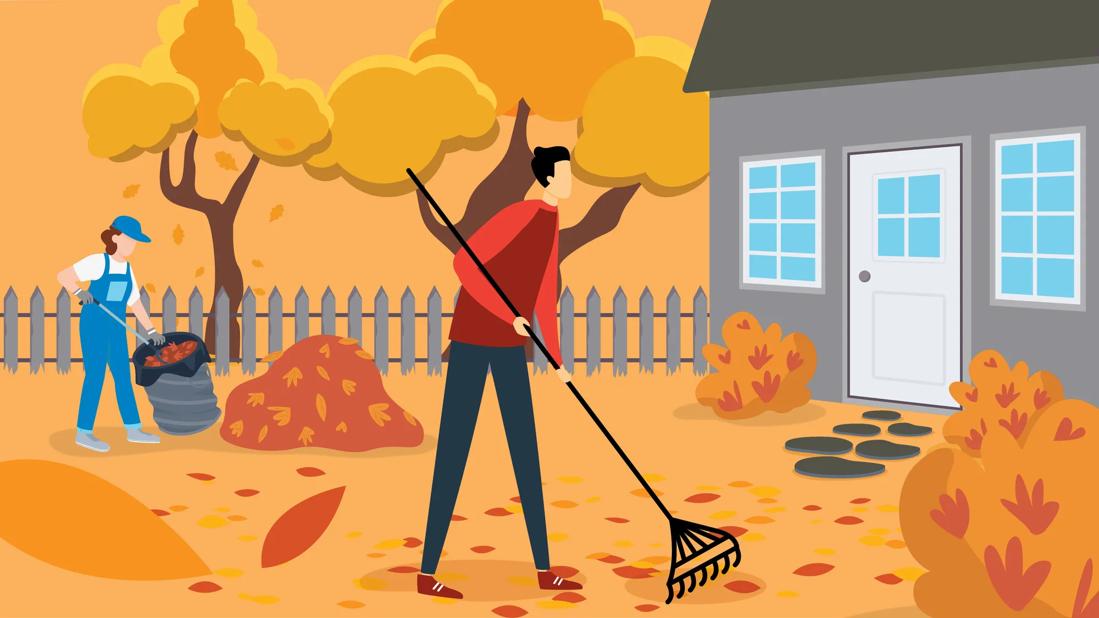Using proper form and the right equipment can help keep you injury-free while gathering up that colorful foliage

Autumn paints the landscape in enough brilliant hues to make “leaf peeping” an annual event. But that visual delight can become a physical pain when those leaves hit the ground and fall cleanup begins.
Advertisement
Cleveland Clinic is a non-profit academic medical center. Advertising on our site helps support our mission. We do not endorse non-Cleveland Clinic products or services. Policy
Raking-related injuries send thousands of people a year to the doctor’s office. Back pain is the most common complaint, but the chore can also take a toll on shoulders, necks, hands … well, you get the not-so-pretty picture.
But if you use proper form while raking, you may feel spry enough afterward to jump in that giant leaf pile to celebrate the season.
Here’s how to get the job done pain-free, courtesy of chiropractor Andrew Bang, DC.
Few of us are in “raking” shape when it comes to fall yard work, says Dr. Bang. The chore asks more out of your back, shoulder and arm muscles than what most typical day-to-day activities demand.
Proper technique and a smart approach — like stretching and warming up before raking — are important if you want to avoid injuries or being so sore that you can barely move the next day.
“Raking is a physical activity, just like a workout,” he explains. “You wouldn’t go to the gym and just start randomly lifting things without any idea of what you’re doing, right? Working in the yard is no different.”
From posture to movement, it’s important to maintain good form while raking leaves to keep from tweaking muscles in your back. Dr. Bang offers these suggestions for when you hit the yard.
Advertisement
Use caution when moving bags of leaves or dragging leaf-filled tarps, too. Whatever you’re grabbing is probably heavier than you think and has the potential to wrench your back and cause injury.
To correctly pick up leaves:
Consider using a wheelbarrow or wagon, too. “It’s a lot easier to roll heavier bags where you need to take them than to lug them there,” says Dr. Bang.
Now that your raking form is all set, let’s address a few other ways you can limit wear and tear from working in the yard this fall.
Advertisement
It’s estimated that up to 84% of adults experience some sort of back pain during their lives. And once your back is injured, it’s more prone to future aches and even the development of arthritis, shares Dr. Bang.
Using proper mechanics while doing yard work or other activities that work your back muscles can help keep you from joining that group.
“It doesn’t take much to tweak your back and create a problem,” he cautions. “Don’t put yourself in a bad position. It’s always better to take precautions to avoid the pain in the first place rather than to try and treat it once it’s there.”
Advertisement
Learn more about our editorial process.
Advertisement

You can improve your athletic performance over time by breaking up your workout regimen into focused cycles

Lower-intensity workouts can deliver high-quality health and fitness results

Incremental changes in your exercise routine can improve your strength and endurance over time

Understanding heart rate zones can help you tailor your workout to reach your goals

Increase the size of your muscles by bulking up on protein and focusing on slow, intense movements with progressive overloading

Low-impact exercises help you recover faster between sets, during cool downs and on rest days

Eccentric is slow and steady, while concentric is fast and controlled

Weightlifting can help you build muscle mass, reduce joint pain and increase flexibility to improve your quality of life

Babies can get congested easily, but you can calm their cough by keeping them hydrated, using nasal drops and running a humidifier

Weight loss may cause loose, sagging skin and muscle loss to your rear

Several conditions, like vitiligo and fungal infection, can cause a loss of pigmentation, leading to white spots or patches on your skin